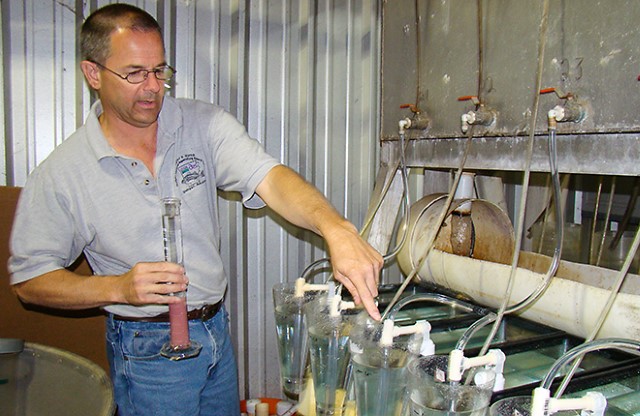Protecting Fish Eggs From Fungus
Fish and other kinds of seafood are recommended by doctors, nutritionists, and government agencies as a good source of the omega-3 fatty acids known to reduce heart disease. The aquaculture industry plays a major role in meeting consumer demand for seafood, and that includes enhancing production.
A major problem for the aquaculture industry is a fungus (Saprolegnia spp.) that attaches to fish eggs and kills them before they hatch. “For the fungus, the easiest source of food is the egg yolk, so the fungus burrows through the shell to get to the yolk,” says David Straus, aquatic toxicologist at the Agricultural Research Service (ARS) Harry K. Dupree Stuttgart National Aquaculture Research Center in Stuttgart, Arkansas. “If you don’t get rid of the fungus, it will destroy the eggs.”
Currently, hatcheries use formalin and hydrogen peroxide—both approved by the U.S. Food and Drug Administration (FDA)—to treat fungus on eggs. Straus and his colleagues have found another solution: copper sulfate.
“Copper sulfate is not approved by the FDA as a drug in aquaculture, but regulatory action is deferred while we work toward gaining approval of it,” Straus says. “Therefore, its use as a drug is currently acceptable.”
Previously, the scientists demonstrated that copper sulfate could be used to prevent fungus on catfish eggs. Straus’s new research shows that copper sulfate also destroys the fungus on sunshine (hybrid striped) bass eggs, which are hatched in a different system—and very quickly (48 hours). The research was published in the North American Journal of Aquaculture in 2016.
Copper sulfate is less expensive, too. “We compared the cost of treating a catfish egg-hatching trough with copper sulfate, formalin, and hydrogen peroxide,” Straus says. “Hydrogen peroxide costs 89 cents, formalin 73 cents, and copper sulfate only 2 cents per treatment. The cost savings would be the same in other hatching systems.”
Straus and his team worked with hatchery managers at Keo Fish Farm, the largest producer of sunshine bass fry and fingerlings (young fish) in the world, who were having problems with fungus on eggs. The company, located in Keo, Arkansas, sells fingerlings to U.S. and international growers, who raise sunshine bass for restaurants and grocery outlets.
In an effectiveness study, eggs were treated with 0, 10, 20, and 40 parts per million (ppm) of copper sulfate for 10 minutes every 12 hours. The best egg survival rate was at 40 ppm, but 20 ppm gave similar results. Eggs treated with 20 ppm had a 46-percent survival rate compared to untreated eggs, which had a 28-percent survival rate.
The scientists also conducted toxicity experiments on sunshine bass larvae, which showed that copper sulfate was a safe and valuable resource for controlling fungus in hatcheries.
Keo Fish Farm currently uses copper sulfate to treat all its eggs. “They estimate that copper sulfate treatment has increased egg hatching by 15 percent,” Straus says.
“We have shown copper sulfate to be an effective treatment for eggs of channel catfish, sunshine bass, largemouth bass, and rainbow trout,” Straus says. “We are in the process of gaining FDA approval to use copper sulfate to treat fungus on catfish eggs and Ich on catfish.” Ich is a protozoan parasite that infects the gills or skin of fish and eventually kills them. “Once we gain FDA approval, copper sulfate can be prescribed for extra-label use on other fish species.”—Sandra Avant, ARS Office of Communications.
Key Facts
- Fungus on fish eggs is major problem for aquaculture.
- Copper sulfate safely prevents fungus on fish eggs.
- Copper sulfate costs less than current fish-egg treatments.
Full Story







